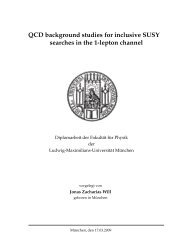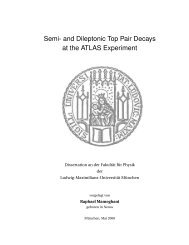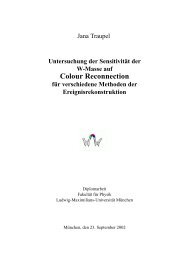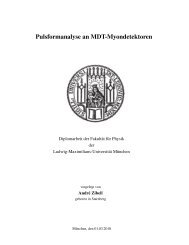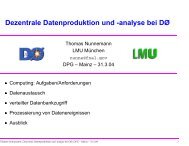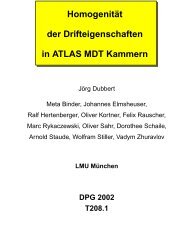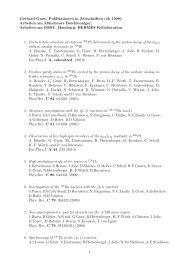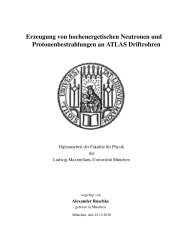development of micro-pattern gaseous detectors – gem - LMU
development of micro-pattern gaseous detectors – gem - LMU
development of micro-pattern gaseous detectors – gem - LMU
You also want an ePaper? Increase the reach of your titles
YUMPU automatically turns print PDFs into web optimized ePapers that Google loves.
58 Chapter 5 Efficiency Determination<br />
photomultiplier<br />
scintillator 1<br />
GEM<br />
scintillator scintillator 22<br />
photomultiplier photomultiplier<br />
z<br />
Sc 2<br />
GEM<br />
MC Simulation θ<br />
ϕ<br />
Sc 1<br />
Figure 5.1: Schematics <strong>of</strong> the defined layers for simulation.<br />
Normalizing this vector with respect to the z-axis defines the vector check[i] and i ∈ [0, 1, 2] :<br />
check[i] = direc[i]<br />
direc[2]<br />
Starting with the detection point posz at the lower scintillator, the check-vector is extrapolated to the<br />
upper scintillators lower and upper surfaces, respectively.<br />
If the endpoint <strong>of</strong> the track lays within the respective rectangle (see Fig. 5.2), the muon has crossed<br />
also the upper scintillator and will be tagged as an ”upper scintillator hit”. The same method can be<br />
applied to checking if this muon also hit the GEM detector. Then it is tagged as a ”GEM hit” muon.<br />
Figure 5.2: Cross section <strong>of</strong> the simulation model. The starting point <strong>of</strong> muons is on the lower scintillator Sc1.<br />
Running this procedure for a large number <strong>of</strong> simulated events and taking the ratio <strong>of</strong> “GEM hits” over<br />
“upper scintillator hits”, one receives the geometrical correction factor fcorr that has to be inserted in<br />
the efficiency calculation:<br />
Sc 2<br />
GEM<br />
Sc 1<br />
ϕ<br />
x<br />
(5.3)



